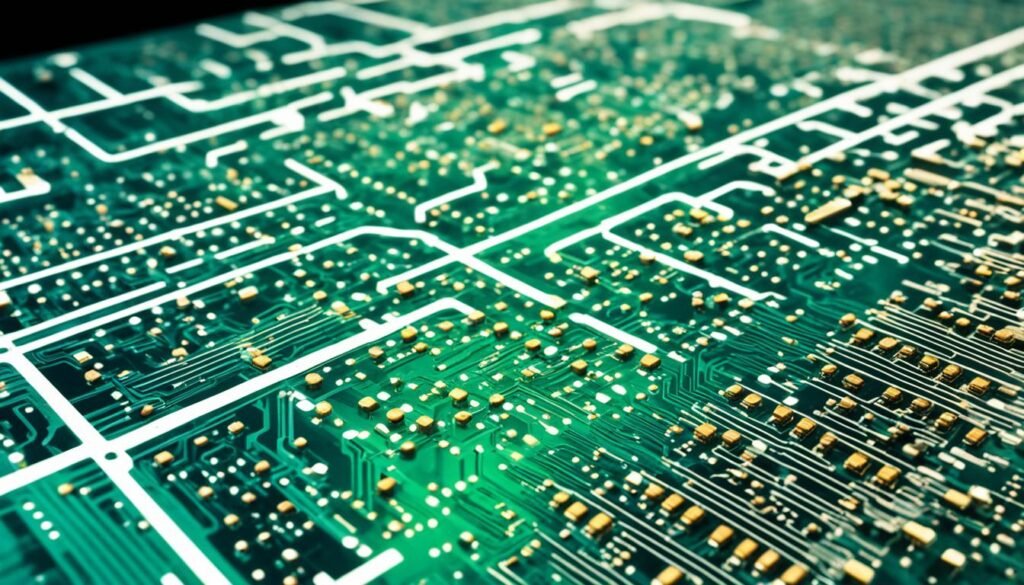Integrated circuits (ICs) are crucial to our high-tech world, found in everything from phones to plants. They make the magic happen in our gadgets. Without these tiny wonders, our devices wouldn’t work the same.
ICs are like mini electronic worlds on a chip. They’re made mostly on silicon, a special type of sand. Think of them as puzzle pieces that complete the picture of our electronics.
They are full of parts like transistors and capacitors, which help them do their job. Because they’re so small, we often call them “microchips”. But don’t let their size fool you, they’re powerful!
Putting all these bits and pieces on a chip has changed our tech. It lets us shrink our devices and make them smarter. Imagine phones that were as big as a house. Impossible without ICs.
Think about it. From the phone in your pocket to huge machines in factories, ICs are there. They are the backbone of today’s technology, helping devices in every field work better every day.
Key Takeaways
- Integrated circuits (ICs) are miniaturized electronic circuits fabricated as a single unit on a semiconductor substrate.
- ICs can be designed to perform a wide range of intended operations, serving as the building blocks of modern electronic systems.
- ICs are packed with millions of tiny transistors, diodes, resistors, capacitors, and other components, enabling the functionality and processing power of electronic devices.
- The integration of complex circuits onto a single chip has driven the rapid evolution and miniaturization of electronic devices across various industries.
- Integrated circuits are the fundamental components that power a vast array of electronic devices, from smartphones and home appliances to industrial equipment and medical devices.
What Is an Integrated Circuit?
An integrated circuit (IC) is a small electronic circuit made on a silicon chip. It performs many tasks designed by engineers. Inside an IC are millions of transistors, diodes, resistors, capacitors, and more. These are connected through the chip’s material called the semiconductor substrate. Because everything is so tiny and close together, we call them microchips. They can be as small as a few square millimeters. This tiny size is a big benefit of integrated circuits.
Also Read: How Do I Report A Cyber Security Incident?
Integrated Circuit Components
The heart of an integrated circuit is made up of transistors, diodes, resistors, and capacitors. These small parts are carefully placed and linked inside the semiconductor substrate. They work together to perform the needed electrical tasks.
Integrated Circuit Size
Over time, the size of integrated circuits has gotten smaller. This happened thanks to improvements in making semiconductors. Today’s ICs can hold millions or even billions of parts in a small chip. This makes microchips more powerful, yet smaller. This change has helped make smaller and better electronic devices that need integrated circuits.
Also Read: What Are The Latest Advancements In Digital Technology?
Integrated Circuit Function
Integrated circuits (ICs) do specific jobs, like amplifying signals and regulating voltages. Each IC works as intended because of how its parts are connected on a tiny chip.
They can be operational amplifiers, voltage regulators, timers, or logic gates. This makes them handy in many tech gadgets and big machines, not just one type.
| Integrated Circuit Function | Description |
|---|---|
| Amplifiers | ICs that can make electrical signals stronger or bigger |
| Oscillators | ICs that create regular electrical signals, like clocks for digital tools |
| Counters | ICs that keep track of events or pulses by counting |
| Voltage Regulators | ICs that keep output voltage steady, no matter what the input is or how heavy the use |
| Timers | ICs that precisely handle time, like making delays or creating pulses |
| Memory | ICs that store and find digital info, allowing data to be saved and used |
| Binary Operations | ICs that do basic logical tasks, like checking binary inputs with AND, OR, and NOT |
| Logic Gates | ICs that handle basic logic, making them the basics of digital setups |
The flexibility and preciseness of these tiny circuits are key for today’s tech world. They make sure our gadgets work well and quickly.
Also Read: How Is Data Stored In Cloud Computing?
Types of Integrated Circuits
Integrated circuits can be sorted into groups based on the signals they handle.
ICs Based on Signal Type
Digital ICs process binary signals with logic gates and flip-flops. They are key to managing digital data.
Analog ICs deal with continuous signals. They include amplifiers and sensors. These circuits work with signals that vary in value, unlike digital signals.
Mixed-signal ICs merge both analog and digital functions on one chip. This allows for combined analog and digital features.
Also Read: What Are The Latest Trends In Innovation Technology?
ICs Based on the Number of Transistors
ICs can also be grouped by the number of transistors inside:
- SSI (Small-Scale Integration) ICs have a few transistors, usually less than 100.
- MSI (Medium-Scale Integration) ICs have hundreds of transistors.
- LSI (Large-Scale Integration) ICs have thousands to millions of transistors.
- VLSI (Very Large-Scale Integration) ICs have millions to billions of transistors.
- ULSI (Ultra-Large-Scale Integration) ICs have billions of transistors.
- GLSI (Giga-Scale Integration) ICs have trillions of transistors.
Advantages and Disadvantages of Integrated Circuits

Integrated circuits (ICs) are key in today’s electronic devices. They bring benefits but also have some downsides.
Also Read: What Role Does Financial Analysis Play In Risk Management?
Advantages
ICs are small but pack a big punch. They can hold many parts in a tiny space. This helps make small yet powerful gadgets. ICs perform well because parts are close together.
ICs are more reliable than other kinds of circuits. They don’t suffer from loose wires like older setups. They are durable and use less power, which is great for things like phones.
Fixing problems with ICs is easier. Their design makes finding and fixing faults simpler. They also are faster because they lack certain kinds of delays.
The best part is, ICs are cheap to make in big numbers. Their low cost helps in making many electronic items affordable.
Disadvantages
But, ICs are not perfect. They can overheat, especially if not designed well. Overheating can lead to devices not working or failing.
ICs are hard to design and build because they’re very complex. Making and fixing them needs special skills and tools. This adds to their challenges.
ICs often need extra parts to work, like inductors and transformers. These parts can make the total cost and complexity of a device go up.
| Advantages | Disadvantages |
|---|---|
| Small size | Risk of overheating |
| Improved performance | Complexity in design and manufacturing |
| Higher reliability | Difficulty in troubleshooting and repair |
| Lower power consumption | Dependence on supporting components (inductors, transformers) |
| Easier troubleshooting | |
| Higher operating speed | |
| Lower cost |
ICs are truly vital for our electronic world. Their pluses like size, performance, reliability, and good prices are outstanding. Yet, issues such as overheating, design complexity, and needing extra parts are important to remember too. These challenges must be faced when using integrated circuits.
How Integrated Circuits Operate in Electronic Devices
Integrated circuits (ICs) are key in making electronic devices work. They power everything from our computer microprocessors to the memory chips. ICs make today’s electronics faster and smarter.
Microprocessors and Central Processing Units
Microprocessors, the brains of devices, are essential ICs. They handle the instructions and math that drive a device’s core functions. For example, in phones and computers, they manage apps and system tasks efficiently with little power usage.
Memory Chips and Data Storage
ICs are crucial for saving and using data. Memory chips, like DRAM, hold the information devices need to operate. They allow gadgets to store everything from photos to software smoothly. Integrated circuits are what keeps all our digital stuff safe and accessible.
Wireless Communication and Networking
ICs also make wireless connections possible. They power Bluetooth and Wi-Fi, letting devices talk to each other. Thanks to ICs, we have IoT and a world where our devices can easily share information, without wires linking them.
Integrated Circuits in Emerging Technologies

Integrated circuits (ICs) are key in pushing new technologies forward. They are at the core of changing how we live and work. Artificial intelligence (AI) and machine learning (ML) are seeing huge jumps thanks to ICs. The Internet of Things (IoT) depends on them too.
Artificial Intelligence and Machine Learning
AI chips and neural network processors lead in AI and ML progress. They handle the tough math and processing needed. For tasks like recognizing images or understanding what we say, these ICs are crucial. They’re used in everything from phones to smart cars, making advanced AI possible.
Internet of Things and Connected Devices
The Internet of Things (IoT) uses a web of connected devices. ICs bring power, communication, and senses to these devices. They let devices share data and work together smoothly. Everything from home gadgets to city systems are growing smarter because of ICs.
Electronic Devices and Their Integrated Circuits

Integrated circuits are like the ‘heart’ for electronic devices. They span many industries and boost how our tech works today. This tech is found in everything from phones to cars and even factories, changing how we use technology in our everyday lives.
Consumer Electronic Devices
Consumer electronics thrive because of integrated circuits. Our smartphones, laptops, and more have these tiny circuits inside. They power everything we do, from calls to streaming movies. ICs allow our devices to be fast, store data, and connect with each other.
These circuits also help our home gadgets work better. They’re in smart home systems, TVs, and even ovens. ICs bring automation and smart features, making our homes more comfortable and efficient.
Automotive and Industrial Electronic Devices
ICs are key for cars and factories too. In cars, they control everything from the engine to safety features. They help vehicles run better and keep us safe on the road.
In factories, ICs are critical for smart technology. They’re in the machines that make products and in systems that check the environment. ICs make industrial work smarter and more productive.
Integration and Miniaturization of Electronic Devices
The pace at which integrated circuit technology is advancing is truly breathtaking. It’s pushing the limits on how small and powerful our gadgets can be. Now, we can fit millions of transistors onto a tiny semiconductor chip. This chip is what powers our smartphones, laptops, and many other devices.
This shrinking of gadgets shows just how fast semiconductor technology is growing. It even confirms something called Moore’s law. Basically, every two years, the number of transistors on a chip doubles. So, our electronic stuff keeps getting smaller, stronger, and more helpful. It’s totally changing the way we use tech every day.
This microchip tech is everywhere, from our phones to our fridges. It’s a big reason why our gadgets are getting better and more connected. This move to smaller, more powerful devices makes technology easier to carry around. Plus, it means our devices can do more without using up as much energy.
And the best part? It’s not stopping. The more we combine and shrink our tech, the more united and responsive our gadgets will be. The future is looking to make our tech experience sleek, connected, and more able to meet our daily needs. This will change how we live, work, and connect with the world in big ways.
Trends and Future of Integrated Circuit Technology

Integrated circuit technology is always growing, with new trends and future changes. A big focus is on making devices smaller, more powerful, and using less energy. This is where improvements are being made:
One key trend is the drive to shrink integrated circuits. The aim is to make smaller chips that are more powerful. This effort follows Moore’s Law, which says transistor density on a chip doubles every two years. This means we get more powerful chips that use less energy.
The area is also seeing a lot more specialized ICs made for specific tasks. For instance, there are now AI chips for learning and edge computing ICs for smarter data processing. These special circuits are great at their jobs, making devices work better and more efficiently.
Then, there’s the rise of 3D packaging. This technology allows layers of integrated circuits to be stacked in a chip. 3D integration boosts the density of components and how well they can communicate. This leads to more compact and powerful system-on-chip designs.
| Trend | Description |
|---|---|
| Miniaturization | Continuous reduction in integrated circuit size, enabling smaller and more powerful chips |
| Specialized ICs | Development of application-specific integrated circuits, such as AI chips and edge computing ICs |
| 3D Packaging | Stacking of multiple integrated circuit layers within a single chip, improving density and performance |
| Energy Efficiency | Ongoing efforts to reduce power consumption and improve energy efficiency of integrated circuits |
These advances show the growing future of integrated circuit technology. They will influence the coming generation of devices, from phones and wearables to big industrial systems. The changes are very exciting.
Also Read: How Does Biotechnology Help In Environmental Conservation?
Conclusion
Integrated circuits form the core of electronic device power and function. They fit millions of components on a single chip. This makes devices smaller, more powerful, and efficient, affecting many fields.
Thanks to ongoing innovations, devices evolve quickly. Think of your smartphone or smart home gadgets. These tiny circuits make advanced features and high-speed connections possible.
The future of electronic devices is exciting. Advancements in chip technology mean smaller, faster, and more efficient devices. They’re also creating chips for new tech like AI and edge computing. This will make our gadgets even more integral to our lives.
FAQs
What are integrated circuits and how do they work in electronic devices?
What are the key components of an integrated circuit?
How do integrated circuits enable the functionality of electronic devices?
What are the different types of integrated circuits?
What are the advantages of integrated circuits?
How do integrated circuits enable emerging technologies and advancements?
What are some of the key applications of integrated circuits in electronic devices?
What are the trends and future developments in integrated circuit technology?
Source Links
- https://www.britannica.com/technology/integrated-circuit
- https://resources.pcb.cadence.com/blog/2023-integrated-circuit-function
- https://www.lenovo.com/us/en/glossary/integrated-circuit/




